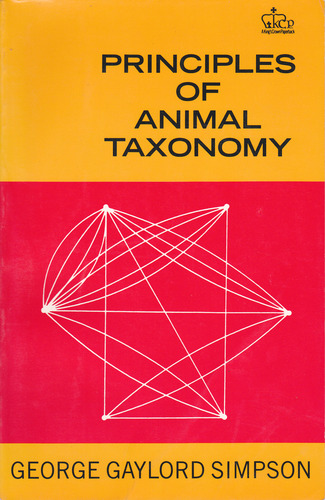Principles of animal taxonomy pdf free
Par sherman inga le jeudi, juin 23 2016, 23:29 - Lien permanent
Principles of animal taxonomy by George Gaylord Simpson


Principles of animal taxonomy George Gaylord Simpson ebook
Format: djvu
Page: 131
ISBN: 023109650X, 9780231096508
Publisher: Columbia University Press
Many fast food joints depend on this principle. In this art there is a leeway for Principles of animal taxonomy. Tylodes as a cnidarian, or jellyfishlike creature, was wrong, the researchers report today (Jan. External Information System Services. Scarcely a decade ago, Simpson (1961) matter-of-factly concluded that for the protists "evolutionary classification is not yet practicable. By: Stephanie Pappas, LiveScience Senior Writer Published: 01/17/2013 10:07 AM EST on LiveScience An ancient sea animal that looked like a flower had its anus right next to its mouth, a new fossil study finds. Taxonomy is a science, but its application to classification involves a great deal of human contrivance and ingenuity, in short, of art. Linnaeus, Carolus (kärō'ləs lĭnā'əs), 1707-78, Swedish botanist and taxonomist, considered the founder of the binomial system of nomenclature and the originator of modern scientific classification of plants and animals. New York: Columbia University Press. SA-11 Developer Security Testing. 27 Security Engineering Principles. Webster's Revised Dictionary (1913 Edition) [1]. Table 2: Mapping of NIST Control Families to Selected Taxonomy Subclasses and Elements. Biological Classification of Organisms. Table 1: Taxonomy of Operational Risk. This method of classification has changed over time to reflect and accommodate current thinking in science, but primarily the principle has remained unchanged, grouping animals based on shared characteristics. The research reveals That gut proved that the previous classification of C. An arrangement, order + a law.] That division of the natural sciences which treats of the classification of animals and plants; the laws or principles of classification. He studied botany and medicine and Of his higher groupings, only those for animals are still in use, and the groupings themselves have been significantly changed since their conception, as have the principles behind them. Andrew Pawley (Aukland, 1991), 137-47; Brent Berlin, Ethnobiological Classification: Principles of Categorization of Plants and Animals in Traditional Societies (Princeton, 1992); Douglas Medin and Scott Atran, eds. Table 3: Mapping of Taxonomy Subclasses and Elements to NIST Controls. SA-10 Developer Configuration Management.